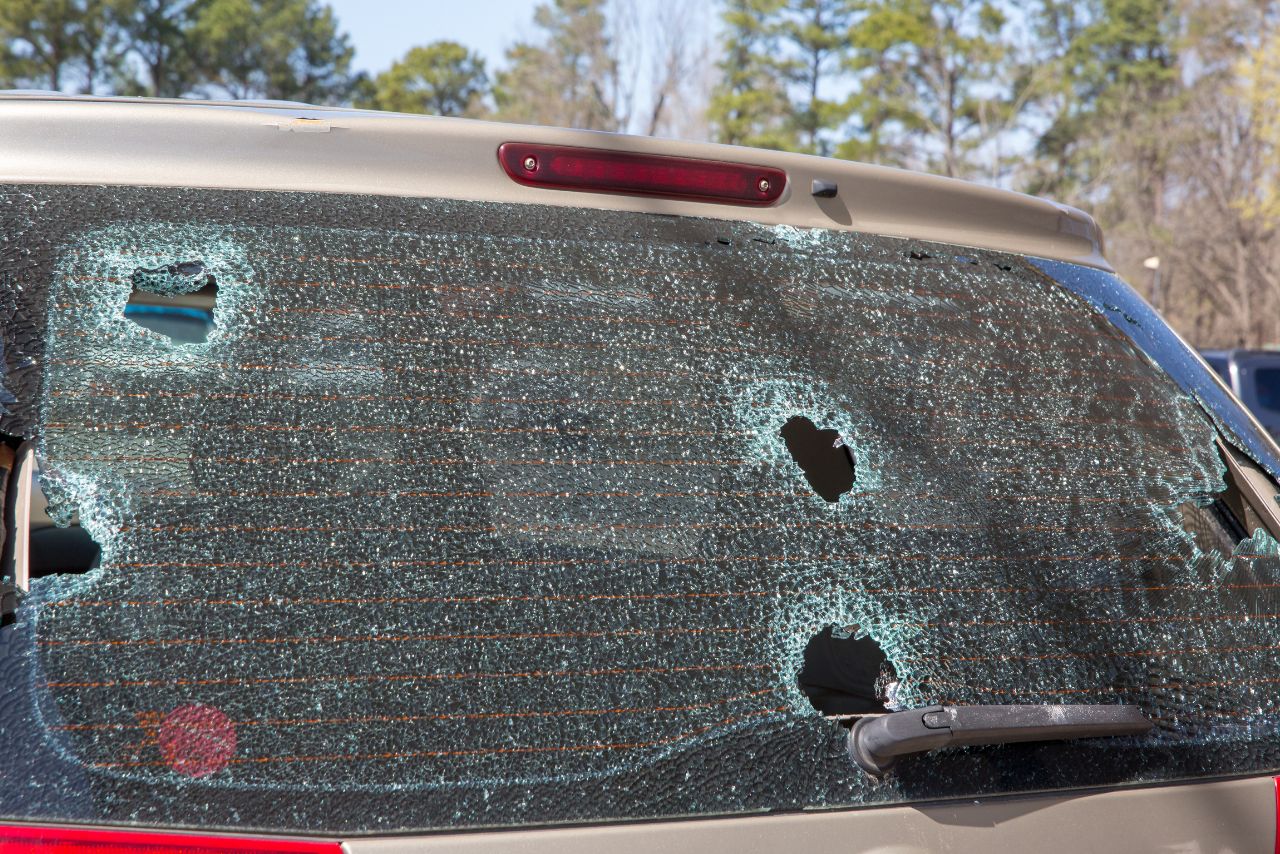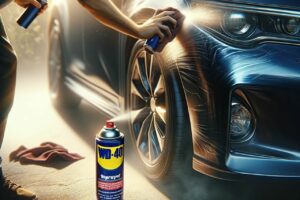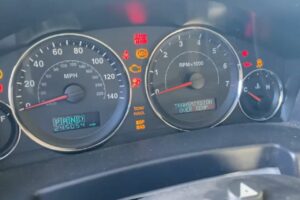Hail storms can produce hailstones of varying sizes, from tiny pea-sized pellets to large golf ball-sized chunks of ice. The potential for hail damage to vehicles and property depends heavily on the size of the hailstones.
So, What Size Hail Will Damage a Car?
Larger hailstones at least one inch or more in diameter tend to cause more significant damage, while smaller hail may leave no more than minor dings or surface chips.
Understanding hail severity and the threat different sized hail poses can help drivers and homeowners assess storm damage and risk.
Table of Contents
What Size Hail Will Damage a Car?
Quarter-sized hail around 1 inch diameter begins damaging vehicle paint and metal while golf ball-sized stones about 1.5 inches result in major exterior harm plus glass breakage; hail must exceed pea-sized thickness to inflict anything beyond minor cosmetic damage on cars.
Can Pea Sized Hail Damage a Roof?
Generally Yes, pea-sized hail can potentially cause damage to a car roof and it can cause many dents on your car. While smaller hailstones may not be as destructive as larger ones, they can still lead to problems over time.
The impact of hail can result in granule loss from asphalt shingles, which can compromise the roof’s integrity.
Additionally, repeated hailstorms or prolonged exposure to hail can contribute to the overall wear and tear of the roof, making it more susceptible to leaks and other issues.
How To Protect Your Car from Hail Damage?
Protecting your car from hail damage involves proactive measures and careful planning. Here are some tips to help safeguard your vehicle during hailstorms:
Garage Parking:
Whenever possible, park your car in a garage or covered parking structure. This provides the most effective protection against hail.
Car Covers: How to Protect Car from Hail if No Garage?
Invest in a high-quality car cover designed to withstand hail. Ensure it fits your vehicle snugly and is securely fastened to prevent wind from lifting it and to Protect Car from Hail if No Garage.
Weather Apps and Alerts:
Stay informed about weather forecasts and hailstorm warnings in your area using weather apps or local news channels. If a hailstorm is predicted, take preventive measures.
Portable Shelter:
Consider portable shelters or car tents that provide temporary protection during hailstorms. These can be set up quickly and offer an extra layer of defense.
Hail Car Cover, Hail Blankets or Mats:
Specialized hail blankets or mats can be placed over your vehicle during a storm to absorb the impact and reduce damage.
Use Nearby Structures:
If a garage or covered parking is unavailable, try to park your car near large buildings or structures that can provide some protection against hail.
Hail Netting:
Install hail netting above your parking space. This netting is designed to deflect or absorb the impact of hailstones.
Check Insurance Coverage:
Ensure that your car insurance policy includes comprehensive coverage, which typically covers hail damage. Review your policy limits and deductibles.
Emergency Preparedness:
Keep an eye on weather updates and be ready to take action if a hailstorm is imminent. Having protective materials like blankets or covers in your car can be useful.
Avoid Parking Under Trees:
While trees provide shade, they can also pose a risk during storms. Branches may break or be knocked down by hail, causing additional damage to your vehicle.
Hail Size Classifications:

The National Weather Service classifies hail by comparing hailstone size to common objects:
| Hail Size | Diameter (inches) | Example Objects |
|---|---|---|
| Pea | 0.25 inch | Pea |
| Marble/mothball | 0.50 inch | Marble, mothball |
| Dime/Penny | 0.75 inch | Dime or penny |
| Nickel | 0.88 inch | Nickel |
| Quarter | 1.00 inch | Quarter |
| Ping-Pong Ball | 1.50 inches | Ping pong ball |
| Golf Ball | 1.75 inches | Golf ball |
| Hen Egg | 2.00 inches | Hen egg |
| Tennis Ball | 2.50 inches | Tennis ball |
| Baseball | 2.75 inches | Baseball |
| Tea Cup | 3.00 inches | Tea cup |
| Grapefruit | 4.00 inches | Grapefruit |
| Softball | 4.50 inches | Softball |
These size comparisons give a sense of perspective on the diameter and severity of hail ranging from smaller pea-sized to larger baseball-sized hailstones.
What Size Hail Will Damage a Car?

The threshold for hail damage to automotive paint, metal, and glass depends on factors like hail size, storm intensity, and exposure time. In general:
Hail Storm Claims for Cars Statistics:
- In 2021, State Farm reported an average hail claim of $5,000, up 16% from 2020.
- A 2018 study by the National Center for Atmospheric Research found that the number of severe hailstorms (those with hailstones one inch or larger) has increased by about 20% since 1950.
- Certain regions are more prone to hailstorms than others. The “Hail Alley” stretching from Texas to North Dakota is especially vulnerable.
Therefore, while tiny pebble-like hail may harm little more than the paint, quarter-sized stones begin introducing moderate damage, with severe penetration and glass breakage seen in hail 1.5 inches (golf ball) or larger.
Does Car Insurance Cover Hail Damage?
Answer is Yes, in many cases, car insurance can cover hail damage. If you have comprehensive coverage as part of your auto insurance policy, it typically includes protection against various non-collision events, such as hailstorms, theft, vandalism, and other natural disasters.
When your vehicle sustains hail damage, you can file a claim with your insurance company to cover the cost of repairs.
However, it’s essential to review your specific policy details, including deductibles and coverage limits, to understand the extent of your protection.
Keep in mind that comprehensive coverage is optional and is not included in basic liability coverage.
If you’re unsure about your coverage or have specific questions, it’s advisable to contact your insurance provider directly to get accurate information about your policy and the coverage it provides for hail damage.
Vehicle Damage by Hail Size:

Reviewing the types of vehicle damage caused by different sized hailstones:
< 1 inch diameter hail
1-2 inch diameter hail:
Over 2 inch diameter hail:
Financial Toll of Hail Damage:
Besides the physical harm hail afflicts, significant economic impacts also arise from hail-induced destruction.
According to a spglobal, hailstorms causing over $34 billion in insured losses have doubled in frequency in the last 20 years. U.S. hail storms accrued around $14 billion in insured damages in 2020, the 4th highest in 50 years.
In total, nearly 9 million U.S. hail damage claims were filed from 2017-2019, totaling over $30 billion in direct vehicle and property losses.
When analyzing the loss ratios and severity distributions of these insurance claim amounts, the average auto hail claim exceeds $4,400 while the mean non-auto claim surpasses $6,000.
Therefore, substantial financial risk exists from hail damage, especially as expansive metro areas suffer more frequent large hailstorms.
This further stresses the importance of comprehending hail severity and safeguarding property appropriately in advance of storms capable of producing damaging hail.
Average Insured Hail Storm Losses By Year:
| Year | Average Losses |
|---|---|
| 2000-2009 | $1.3 billion |
| 2010-2018 | $3.4 billion |
| 2020 | $14 billion |
| 2023 | $34 billion |
FAQs:
Can pea-sized hail cause damage?
Yes, while pea-sized hail is relatively small, it can still cause damage to various surfaces, including cars. The impact of hailstones, even if they are small, can lead to dents, scratches, and other cosmetic damage.
Does penny-sized hail cause damage?
Yes, penny-sized hail, which is typically around 0.75 inches in diameter, can cause damage to vehicles. The impact of hailstones of this size can result in dents and other cosmetic issues on the car’s exterior.
Can small hail dents be fixed?
Yes, small hail dents can often be fixed. Paintless Dent Repair (PDR) is a common method used to address minor dents caused by hail. PDR involves massaging the dent from the inside, preserving the original paint finish without the need for repainting.
How do you pop small hail dents?
These include utilizing natural heat sources like the sun, where parking the vehicle in direct sunlight can warm the metal. Once warm, gently massaging or pushing the dent from the inside may be attempted.
Another method involves using a hairdryer to heat the dented area, followed by a gentle massage from the inside. Additionally, some individuals use dry ice to contract the metal by applying it directly to the dent.
However, it’s crucial to approach these DIY methods with caution, as results can vary. Professional dent removal services, especially those employing techniques like Paintless Dent Repair, are generally more effective and safer for preserving the vehicle’s finish.
How do you get small hail dents out of a car?
To get small hail dents out of a car, consider professional techniques like Paintless Dent Repair (PDR). This method involves specialized tools and techniques to gently massage the dents from the inside, restoring the affected areas without the need for extensive repainting. It’s advisable to consult with a qualified auto body professional for the best results.
Conclusion and final thoughts
The potential for hail to damage a car depends on the size of the hailstones. While small hail, such as pea-sized pellets, may not cause significant harm, larger hailstones can pose a real threat to a vehicle’s exterior.
The size of hail that can cause damage typically starts at around golf ball size (1.75 inches in diameter) and increases with larger hailstones.
Car owners should be aware of the weather conditions in their region and consider protective measures, such as parking in a covered area during severe storms, to minimize the risk of hail damage.
Additionally, having comprehensive car insurance can provide financial protection in the event of hail-related damage, allowing for timely repairs and ensuring the longevity of the vehicle.
Latest Posts:
- Can WD-40 Remove Scratches on Cars? (Hint: Yes, but…)
- Can You Use a Drill to Polish Your Car? (We Tried it Out!)
- Should You Cover Car Scratches With Stickers? (REVEALED!)
- Buick Service Stabilitrak: (Causes & 100% Guaranteed Fix!)
- Common Holden Trax Problems (Causes & 100% Proven Fixes!)
- Jeep Commander Transmission Over Temp: (Guaranteed Fix!)












Leave a Reply